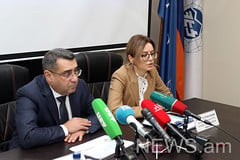
Today I addressed the OSCE Chairman-in-Office, the UN and the CoE Secretary Generals, the UN and the CoE Commissioners for Human Rights, the PACE and the OSCE PA Presidents, the ECHR President, the PACE Co-Rapporteurs on Azerbaijan and Armenia, as well as other partners, including several ombudspersons and their associations with questions on the illegitimacy of the process of determining Armenia's state borders and gross human rights violations. The Human Rights Defender (Ombudsman) of Armenia, Arman Tatoyan, on Friday wrote this on Facebook.
“The letters state that the process of determining Armenia's borders with Azerbaijan is being carried out by Azerbaijan under open threats of war against the entire population of Armenia. The President of Azerbaijan speaks about the Armenian people worldwide and the population of Armenia in the language of ethnic cleansing and open threats of genocide, as does the President of Turkey. Following the example of the President of Azerbaijan, in general, public figures openly insult the dignity of the Armenian people and incite hostility on the basis of ethnicity (specific evidence is attached).
As a result, the border demarcation process in specific settlements of Syunik and Gegharkunik regions of Armenia has already led to gross violations of internationally recognized human socio-economic [property, etc.] rights and seriously endangered people's rights to life and physical immunity. The best interests of children to live and develop in a peaceful, non-violent environment have been violated. The security of the state borders of the Republic of Armenia has been endangered.
In other words, the process is unaccompanied by the requirements of the rule of law and as thus, it has absolutely no legitimacy.
Therefore, it should be stopped immediately and be subject to a fundamental review.
The letters of the Human Rights Defender of Armenia emphasize that internationally absolutely unacceptable mechanical approaches are the only methods being used in the process of determining the borders, including the use of a GPS or Google Map application of a private company. No internationally recognized criteria are taken into account.
There are no professional approaches at all, no commission work is carried out, no preliminary inventory and assessment of people's needs is carried out, and there are no proper legal bases.
In the immediate vicinity of the civilians of Armenia or in the settlements themselves [For example, in the large communities of Goris and Kapan, Syunik region, on interstate or intercommunity roads, or directly on the sidewalk, directly in the settlement], Azerbaijani soldiers, i.e. armed men, were deployed.
The tripartite declaration of November 9, 2020 or any other document does not set an accessible and predictable schedule for the people on the process of determining the state borders of the Republic of Armenia.
Due to all of this, the impermissible speed of the border demarcation process and especially the lack of proper information directly related to the rights of border residents has led to uncertainty and unpredictable situations.
The ombudsman's letters state that any human rights process must be based on the rule of law and, consequently, on internationally recognized human rights [which are also guaranteed by the Constitution within our country]. This is a fundamental principle of democracy.
It is obvious that in the current situation, the entire process of determining the borders of the Republic of Armenia as described above undermines the foundations of the international human rights system, and completely contradicts the very basic principles for which modern international law has been established since World War Two: to guarantee human rights and peace.
Individually signed letters are sent to each of the international organizations and colleagues, in accordance with the jurisdiction vested in each recipient, with each correspondence supported by detailed analysis,” Tatoyan added.






















